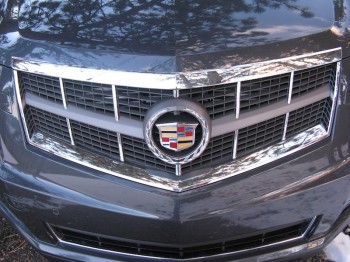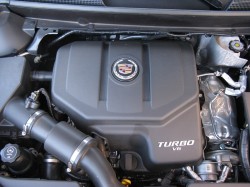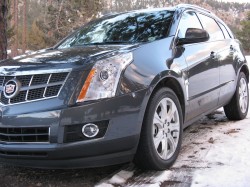2010 SRX - Ride and Performance
Part 1 - OverviewPart 2 - Our test carPart 3 - Exterior and DesignPart 4 - Interior and ElectronicsPart 5 - Ride and Performance
Image galleries - SRX Review Pics | SRX Pics from Cadillac Finally, we are about to cover a lot of nitty-gritty on the systems and features that come together to make up the result we would generically call the SRX’s ‘ride and handling’. This includes things like a 2.8l turbo V-6 engine, Haldex AWD system, ZF/Sachs adjustable performance shocks, and Cadillac’s handling and safety systems like StabiliTrak traction and stability control.
But, what you really need to know is this:
It all doesn’t matter in the slightest. All you really need to know is that the SRX does things on the road and has moves that no 2-ton plus, upgraded Equinox, tall wagon has any right to do. Our handling loop normally makes lesser cars and drivers cower in fear. SUVs are rare here, as most folks go for all-wheel drive cars for their lower center-of-gravity and better handling on these roads. The SRX ate this drive like nothing I’ve driven in quite a while. It is honestly hard to believe that the vehicle you climbed into is the one you are driving.
Roll control was insane. No matter the curve, there was none of the lean you experience in the average car, much less a crossover. I took subsequent drives on the loop faster and faster trying to find when its ‘crossover-ness’ would rear its ugly head - but it never did. It seems that Cadillac somehow gotten around some of the less convenient laws of physics.
Ride, which you might expect to be harsh as a result (*cough* BMW X3 *cough*) was pleasantly smooth and never harsh – in keeping with its luxury role. The shocks in this trim are ZF/Sachs units that have a sport mode (more on that later) and sample the road to determine the best damping rate.
Finally, we are about to cover a lot of nitty-gritty on the systems and features that come together to make up the result we would generically call the SRX’s ‘ride and handling’. This includes things like a 2.8l turbo V-6 engine, Haldex AWD system, ZF/Sachs adjustable performance shocks, and Cadillac’s handling and safety systems like StabiliTrak traction and stability control.
But, what you really need to know is this:
It all doesn’t matter in the slightest. All you really need to know is that the SRX does things on the road and has moves that no 2-ton plus, upgraded Equinox, tall wagon has any right to do. Our handling loop normally makes lesser cars and drivers cower in fear. SUVs are rare here, as most folks go for all-wheel drive cars for their lower center-of-gravity and better handling on these roads. The SRX ate this drive like nothing I’ve driven in quite a while. It is honestly hard to believe that the vehicle you climbed into is the one you are driving.
Roll control was insane. No matter the curve, there was none of the lean you experience in the average car, much less a crossover. I took subsequent drives on the loop faster and faster trying to find when its ‘crossover-ness’ would rear its ugly head - but it never did. It seems that Cadillac somehow gotten around some of the less convenient laws of physics.
Ride, which you might expect to be harsh as a result (*cough* BMW X3 *cough*) was pleasantly smooth and never harsh – in keeping with its luxury role. The shocks in this trim are ZF/Sachs units that have a sport mode (more on that later) and sample the road to determine the best damping rate.
 Straight-line performance is certainly in keeping with the turbo model's sporting angle, in part due to its incredibly low rpm torque peak. I'd love to see what this would do in place of the normally aspirated 3.6 in the lighter CTS. Previously, this 2.8 turbo has seen duty in the Saab 9-3 Turbo-X, also tied to the same Haldex all-wheel drive system we get in the SRX. The advantage of this system is that Cadillac gets the benefits of the Saab XWD (Cross-wheel drive) system rather than trying to performance tune the all-wheel drive used in lesser Theta crossovers.
Speaking of the sporting nature of the all-wheel drive system, Cadillac features a electronically controlled rear differential that in other luxury crossovers would result in tacky badging emblazoned across the rear facia (I'm looking at you, Acura, and your 'Super Handling AWD'). The system uses the rear differential to vector torque to the wheel that will help rotate the vehicle into a corner, offsetting the natural tendency to understeer). This is a great feature that requires all-wheel drive hardware to pull off. Without the ability to over-drive a wheel in this way, you'd be limited to using brakes to help alter trajectory.
So, with the turbo power running through a torque vectoring all-wheel drive system, all controlled on the road by the black magic of the Sachs units at each corner and you get something seemingly much greater than the sum of its parts. Honestly, in its time in our hands, I found myself thinking it might just be the perfect car for my personal mountain road drive - a crossover mind you, not the sports cars I normally lust for in my daily drive – a testament to the chassis tuning artists working at Cadillac now.
All of this without dipping toes into the SRX's more performance oriented sport mode. Rather than offering a button on the dash like other manufacturers to tell the SRX's computers that you're ready to play, the SRX engineers were smart enough to realize that sporty driving maps pretty directly to switching the 6-speed automatic into its manual shifting mode. Doing so causes the center Driver Information Center to temporarily display 'Sport Mode' to announce the change. Also, this instructs the various computers to tell the transmission to engage its sport program (hold gears longer, downshift more readily, etc) as well as triggering a host of changes in other systems that also support this requested change of behavior – from throttle to suspension.
We found the sport mode to be a great idea, in theory, while somehow being left somewhat cold by its behavior. For one, the suspension, which is supposedly taking cues from the sport mode to enable sportier driving…you just don't feel a change. We tried switching it on and off to detect changes in ride - there seemed to be next to none while also looking for some change in handling (roll control, etc). This is as much credit to the excellent tuning of the base mode that sport really doesn't seem to have much to do, suspension-wise.
Steering is a similar story. With the SRX's electric steering assist, you'd expect a notable change in steering effort/and or feedback. The changes, are so subtle that most might never notice they are there. However, again, the base tune is just fine, so a change really isn't needed in the first place.
So, while Cadillac has made an attempt to give the sporty SRX a full-on sport mode, they seem to have pulled much of the sportiness into the base tune so much that the sport mode ends up being practically indistinguishable.
The exception to this rule is in the transmission tuning. The standard tricks we mentioned before are there, but more so than that is a change of behavior during braking. The transmission seems to hold the torque converter in a locked state (likely for more direct response when going from braking to power) and you really feel it disengage during the last few car-lengths of a stop. It isn't jarring, but is certainly noticeable when it occurs.
So, this is one vehicle that likely could have gone either with a softer base tune to give it some space between normal and sport - or simply adding a bit more intelligence to auto-detect aggressive driving and engage the sport features without the driver having to manually ask for it. Alternatively, they could have decided to turn up the sport firmness even more.
Straight-line performance is certainly in keeping with the turbo model's sporting angle, in part due to its incredibly low rpm torque peak. I'd love to see what this would do in place of the normally aspirated 3.6 in the lighter CTS. Previously, this 2.8 turbo has seen duty in the Saab 9-3 Turbo-X, also tied to the same Haldex all-wheel drive system we get in the SRX. The advantage of this system is that Cadillac gets the benefits of the Saab XWD (Cross-wheel drive) system rather than trying to performance tune the all-wheel drive used in lesser Theta crossovers.
Speaking of the sporting nature of the all-wheel drive system, Cadillac features a electronically controlled rear differential that in other luxury crossovers would result in tacky badging emblazoned across the rear facia (I'm looking at you, Acura, and your 'Super Handling AWD'). The system uses the rear differential to vector torque to the wheel that will help rotate the vehicle into a corner, offsetting the natural tendency to understeer). This is a great feature that requires all-wheel drive hardware to pull off. Without the ability to over-drive a wheel in this way, you'd be limited to using brakes to help alter trajectory.
So, with the turbo power running through a torque vectoring all-wheel drive system, all controlled on the road by the black magic of the Sachs units at each corner and you get something seemingly much greater than the sum of its parts. Honestly, in its time in our hands, I found myself thinking it might just be the perfect car for my personal mountain road drive - a crossover mind you, not the sports cars I normally lust for in my daily drive – a testament to the chassis tuning artists working at Cadillac now.
All of this without dipping toes into the SRX's more performance oriented sport mode. Rather than offering a button on the dash like other manufacturers to tell the SRX's computers that you're ready to play, the SRX engineers were smart enough to realize that sporty driving maps pretty directly to switching the 6-speed automatic into its manual shifting mode. Doing so causes the center Driver Information Center to temporarily display 'Sport Mode' to announce the change. Also, this instructs the various computers to tell the transmission to engage its sport program (hold gears longer, downshift more readily, etc) as well as triggering a host of changes in other systems that also support this requested change of behavior – from throttle to suspension.
We found the sport mode to be a great idea, in theory, while somehow being left somewhat cold by its behavior. For one, the suspension, which is supposedly taking cues from the sport mode to enable sportier driving…you just don't feel a change. We tried switching it on and off to detect changes in ride - there seemed to be next to none while also looking for some change in handling (roll control, etc). This is as much credit to the excellent tuning of the base mode that sport really doesn't seem to have much to do, suspension-wise.
Steering is a similar story. With the SRX's electric steering assist, you'd expect a notable change in steering effort/and or feedback. The changes, are so subtle that most might never notice they are there. However, again, the base tune is just fine, so a change really isn't needed in the first place.
So, while Cadillac has made an attempt to give the sporty SRX a full-on sport mode, they seem to have pulled much of the sportiness into the base tune so much that the sport mode ends up being practically indistinguishable.
The exception to this rule is in the transmission tuning. The standard tricks we mentioned before are there, but more so than that is a change of behavior during braking. The transmission seems to hold the torque converter in a locked state (likely for more direct response when going from braking to power) and you really feel it disengage during the last few car-lengths of a stop. It isn't jarring, but is certainly noticeable when it occurs.
So, this is one vehicle that likely could have gone either with a softer base tune to give it some space between normal and sport - or simply adding a bit more intelligence to auto-detect aggressive driving and engage the sport features without the driver having to manually ask for it. Alternatively, they could have decided to turn up the sport firmness even more.
 In addition to a sport mode that seems a bit subtle, there is one other area where the SRX could use some work. The brakes, while plenty powerful and never exhibiting any fade in our use, seemed to require more travel than we would have preferred to scrub off the speed we wanted. This was likely an effort to smooth the driving experience in stop-and-go, but it meant that in more aggressive/demanding situations you could be unpleasantly surprised (or, if you aren't as diplomatic - scared) when you find yourself having to suddenly dial in more effort than you expected to get the speed down. This could be an expensive flaw if you happened to need the brakes to keep a close call from becoming a collision.
So, there you have it. The SRX could likely be the crossover you've been waiting for if you like your tall-wagons on the sporty-side. A nice niche to be in if you are Cadillac and trying to steal some buyers away from other entries in this segment.
If you're a die-hard Lexus fan, this might be too edgy for you (in both styling and ride/handling compromise). But if you are looking for a hauler with some sporting pretensions - and can overlook a few of the quirks - then the SRX is the ride for you.
In addition to a sport mode that seems a bit subtle, there is one other area where the SRX could use some work. The brakes, while plenty powerful and never exhibiting any fade in our use, seemed to require more travel than we would have preferred to scrub off the speed we wanted. This was likely an effort to smooth the driving experience in stop-and-go, but it meant that in more aggressive/demanding situations you could be unpleasantly surprised (or, if you aren't as diplomatic - scared) when you find yourself having to suddenly dial in more effort than you expected to get the speed down. This could be an expensive flaw if you happened to need the brakes to keep a close call from becoming a collision.
So, there you have it. The SRX could likely be the crossover you've been waiting for if you like your tall-wagons on the sporty-side. A nice niche to be in if you are Cadillac and trying to steal some buyers away from other entries in this segment.
If you're a die-hard Lexus fan, this might be too edgy for you (in both styling and ride/handling compromise). But if you are looking for a hauler with some sporting pretensions - and can overlook a few of the quirks - then the SRX is the ride for you.
